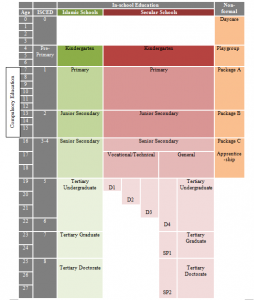This map of Indonesia’s education system was developed using UNESCO’s International Standard Classification of Education (ISCED) which was designed “to facilitate comparisons of education statistics and indicators across countries on the basis of uniform and internationally agreed definitions” (UNESCO, 2011). Please click on the image to view it in more detail.
The acknowledgement of Indonesia’s diverse cultural roots can be seen in the structure of the current education system. Islamic schools still operate side-by-side with secular schools from kindergarten to the post-graduate level. About 15% of students attend Islamic primary schools. Due to this dual education structure, and also because religion is a subject taught in secular schools as well, both the Ministry of National Education (MONE) and the Ministry of Religious Affairs (MORA) are involved in overseeing the nation’s education administration (Frederick & Worden, 2011).
Education is compulsory for the first nine years, six years in primary school and three years in junior secondary school. The completion rate for compulsory education nationally is over 90%, with the literacy rate upon completion at nearly 100%. About 75% of students continue on to secondary education, and 27% of all students go on to enroll at the tertiary level (UNESCO, 2013). Students begin to track into different professions from senior secondary school where, after completing one year of general education, they can decide to have either a general, vocational, or technical focus for the remaining two years. Upon graduation, they can choose to enter a professional program to earn a diploma in one to four years, depending on the kind of program, or to continue academic studies, which would put them on track to earn a master’s or PhD level degree. Once students begin to track into their different fields in senior secondary school, it is difficult to deviate. There is also no path built into Indonesia’s education system to allow students to re-enter and pursue a different course of study.
Click here to learn about Indonesia’s regional and international partnerships



